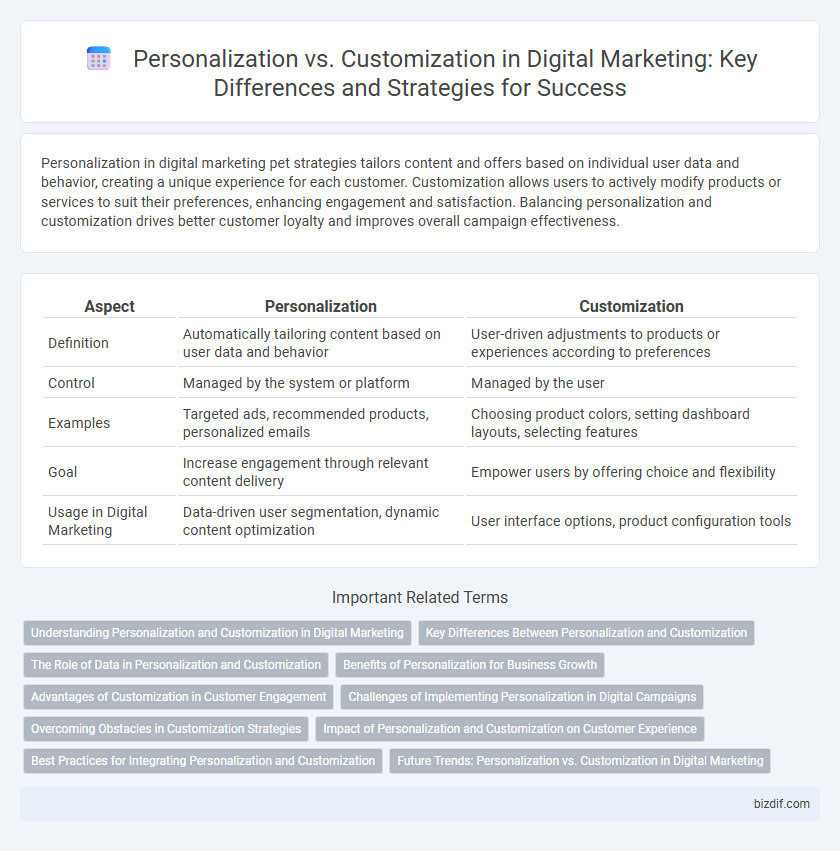Personalization in digital marketing pet strategies tailors content and offers based on individual user data and behavior, creating a unique experience for each customer. Customization allows users to actively modify products or services to suit their preferences, enhancing engagement and satisfaction. Balancing personalization and customization drives better customer loyalty and improves overall campaign effectiveness.
Table of Comparison
| Aspect | Personalization | Customization |
|---|---|---|
| Definition | Automatically tailoring content based on user data and behavior | User-driven adjustments to products or experiences according to preferences |
| Control | Managed by the system or platform | Managed by the user |
| Examples | Targeted ads, recommended products, personalized emails | Choosing product colors, setting dashboard layouts, selecting features |
| Goal | Increase engagement through relevant content delivery | Empower users by offering choice and flexibility |
| Usage in Digital Marketing | Data-driven user segmentation, dynamic content optimization | User interface options, product configuration tools |
Understanding Personalization and Customization in Digital Marketing
Personalization in digital marketing involves delivering tailor-made content and experiences based on individual user data, such as browsing behavior and purchase history, to enhance engagement and conversion rates. Customization allows users to actively modify products or services to meet their unique preferences, fostering a sense of control and satisfaction. Understanding the distinction between personalization's algorithm-driven approach and customization's user-controlled options is crucial for creating effective marketing strategies that boost customer loyalty and improve ROI.
Key Differences Between Personalization and Customization
Personalization in digital marketing uses data-driven insights and algorithms to automatically tailor content and experiences to individual users, enhancing engagement through predictive behavior analysis. Customization empowers users to manually modify their interactions or preferences, offering control over the brand experience and fostering a sense of ownership. The key difference lies in automation versus user control: personalization is marketer-driven and seamless, while customization is user-initiated and interactive.
The Role of Data in Personalization and Customization
Data drives the effectiveness of personalization and customization in digital marketing by enabling brands to deliver relevant content and tailored experiences. Personalization leverages customer behavior, preferences, and demographic data to automatically adjust messaging, while customization allows users to actively modify products or interfaces based on their specific needs. Advanced analytics and machine learning algorithms process vast datasets to optimize these strategies, enhancing engagement and conversion rates.
Benefits of Personalization for Business Growth
Personalization enhances customer engagement by delivering tailored content and offers based on individual preferences and behavior, increasing conversion rates and brand loyalty. It enables businesses to gather valuable data insights, optimizing marketing strategies and resource allocation for higher ROI. Implementing personalization fosters a more meaningful customer experience, driving sustained business growth and competitive advantage in the digital marketplace.
Advantages of Customization in Customer Engagement
Customization enhances customer engagement by allowing users to modify products or services according to their specific preferences, creating a unique and interactive experience. This tailored interaction increases customer satisfaction and loyalty as individuals feel more valued and understood. Moreover, customization drives higher conversion rates and repeat purchases by offering relevance that aligns closely with consumer needs and expectations.
Challenges of Implementing Personalization in Digital Campaigns
Implementing personalization in digital marketing campaigns faces challenges such as data privacy concerns, which limit access to detailed consumer behavior insights necessary for tailored content. Additionally, integrating diverse data sources to create a unified customer profile requires advanced analytics and sophisticated technology infrastructure. Overcoming these obstacles demands ongoing investment in compliance measures and innovative tools to deliver relevant, personalized experiences at scale.
Overcoming Obstacles in Customization Strategies
Overcoming obstacles in customization strategies requires addressing data integration challenges and ensuring seamless user experiences across platforms. Advanced AI tools and machine learning algorithms enable marketers to analyze customer behavior at scale, facilitating more precise customization while maintaining privacy compliance. Leveraging dynamic content and real-time analytics optimizes customization efforts, reducing friction and enhancing engagement metrics.
Impact of Personalization and Customization on Customer Experience
Personalization enhances customer experience by utilizing data analytics and AI to deliver tailored content, offers, and recommendations that align with individual preferences and behaviors. Customization empowers customers to modify products or services according to their specific needs, increasing engagement and satisfaction through active participation. Both strategies drive higher conversion rates, loyalty, and customer lifetime value by creating more relevant and meaningful interactions in digital marketing campaigns.
Best Practices for Integrating Personalization and Customization
Effective integration of personalization and customization in digital marketing hinges on leveraging data-driven insights to deliver tailored content while empowering users with control over their experience. Employ advanced analytics and AI to predict user preferences for dynamic personalization, while providing intuitive customization options to enhance engagement and satisfaction. Seamless alignment between automated personalization algorithms and user-driven customization settings ensures a highly relevant and interactive digital journey.
Future Trends: Personalization vs. Customization in Digital Marketing
Future trends in digital marketing emphasize hyper-personalization driven by AI and big data analytics, enabling brands to deliver tailored content based on real-time user behavior and preferences. Customization remains crucial as interactive platforms empower consumers to design products or experiences, but the focus shifts towards seamless integration between automated personalization and user-driven customization. Innovations in machine learning and predictive analytics are set to enhance customer journey mapping, creating dynamic and adaptive marketing strategies that evolve with individual customer needs.
Personalization vs Customization Infographic

 bizdif.com
bizdif.com